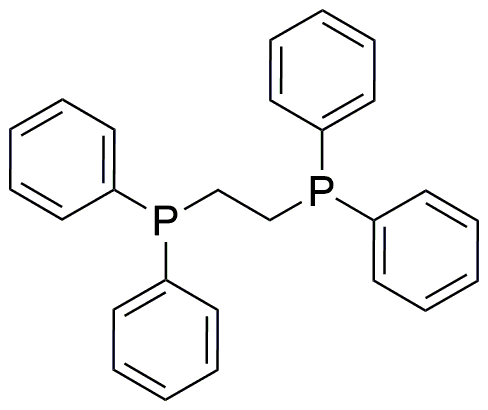1,2-Bis(diphenylphosphino)ethane is widely utilized in research focused on:
- Catalysis: This compound serves as an effective ligand in various catalytic processes, particularly in transition metal catalysis, enhancing reaction rates and selectivity in organic synthesis.
- Organometallic Chemistry: It is commonly used in the preparation of organometallic complexes, which are crucial for developing new materials and pharmaceuticals.
- Pharmaceutical Development: The compound plays a significant role in drug discovery, aiding in the design of new therapeutic agents by facilitating complex chemical reactions.
- Polymer Science: It is employed in the synthesis of advanced polymers, contributing to the development of materials with tailored properties for specific applications.
- Environmental Chemistry: This chemical is utilized in the study of environmental remediation processes, helping to develop methods for removing pollutants from soil and water.
General Information
Properties
Safety and Regulations
Applications
1,2-Bis(diphenylphosphino)ethane is widely utilized in research focused on:
- Catalysis: This compound serves as an effective ligand in various catalytic processes, particularly in transition metal catalysis, enhancing reaction rates and selectivity in organic synthesis.
- Organometallic Chemistry: It is commonly used in the preparation of organometallic complexes, which are crucial for developing new materials and pharmaceuticals.
- Pharmaceutical Development: The compound plays a significant role in drug discovery, aiding in the design of new therapeutic agents by facilitating complex chemical reactions.
- Polymer Science: It is employed in the synthesis of advanced polymers, contributing to the development of materials with tailored properties for specific applications.
- Environmental Chemistry: This chemical is utilized in the study of environmental remediation processes, helping to develop methods for removing pollutants from soil and water.
Documents
Safety Data Sheets (SDS)
The SDS provides comprehensive safety information on handling, storage, and disposal of the product.
Product Specification (PS)
The PS provides a comprehensive breakdown of the product’s properties, including chemical composition, physical state, purity, and storage requirements. It also details acceptable quality ranges and the product's intended applications.
Certificates of Analysis (COA)
Search for Certificates of Analysis (COA) by entering the products Lot Number. Lot and Batch Numbers can be found on a product’s label following the words ‘Lot’ or ‘Batch’.
Numéro de catalogue
Numéro de lot/série
Certificates Of Origin (COO)
This COO confirms the country where the product was manufactured, and also details the materials and components used in it and whether it is derived from natural, synthetic, or other specific sources. This certificate may be required for customs, trade, and regulatory compliance.
Numéro de catalogue
Numéro de lot/série
Safety Data Sheets (SDS)
The SDS provides comprehensive safety information on handling, storage, and disposal of the product.
DownloadProduct Specification (PS)
The PS provides a comprehensive breakdown of the product’s properties, including chemical composition, physical state, purity, and storage requirements. It also details acceptable quality ranges and the product's intended applications.
DownloadCertificates of Analysis (COA)
Search for Certificates of Analysis (COA) by entering the products Lot Number. Lot and Batch Numbers can be found on a product’s label following the words ‘Lot’ or ‘Batch’.
Numéro de catalogue
Numéro de lot/série
Certificates Of Origin (COO)
This COO confirms the country where the product was manufactured, and also details the materials and components used in it and whether it is derived from natural, synthetic, or other specific sources. This certificate may be required for customs, trade, and regulatory compliance.


